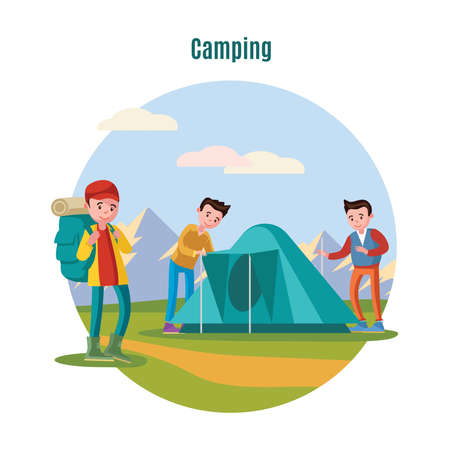Understanding Your Campout Crew
Before you start buying ingredients or planning meals, it’s important to understand who you’re cooking for. When youre feeding a large group on a camping trip, knowing everyones dietary needs and preferences helps avoid waste and ensures everyone stays happy and well-fed.
Identify Dietary Preferences
Start by checking if anyone in your group has food allergies, intolerances, or specific diets like vegetarian, vegan, gluten-free, or keto. This allows you to plan meals that accommodate everyone without needing to make multiple versions of the same dish.
Consider Age Ranges
Kids usually eat smaller portions than adults, and they might be pickier too. On the other hand, teens and active adults may need more calories to stay energized throughout the day. Here’s a simple breakdown to help estimate portion sizes:
| Age Group | Typical Portion Size | Notes |
|---|---|---|
| Children (4–10) | ½ – 1 adult portion | Prefer simple foods; avoid spicy dishes |
| Teens (11–17) | 1 – 1½ adult portions | High energy needs; include hearty meals |
| Adults (18+) | Standard portion | Balance carbs, protein, and veggies |
| Seniors (65+) | ¾ – 1 adult portion | Might prefer softer foods or lighter meals |
Create a Quick Meal Profile List
A simple way to stay organized is to make a checklist of each camper’s name along with their food preferences or restrictions. Heres an example:
| Name | Age | Dietary Needs | Food Likes/Dislikes |
|---|---|---|---|
| Samantha | 8 | No dairy | Loves pasta, dislikes beans |
| Mike | 15 | No restrictions | Loves burgers and chili |
| Aunt Carol | 66 | Low sodium diet | PREFERS soups and grilled veggies |
The Bottom Line for Meal Planning Success
The better you understand your campout crew, the easier it becomes to plan affordable meals that satisfy everyone. Take the time up front to organize these details—it’ll save you money, reduce food waste, and help make your camping experience stress-free and enjoyable.
2. Smart Grocery Planning on a Budget
Feeding a large family during a campout doesn’t have to break the bank. With some smart grocery planning, you can enjoy tasty and nutritious meals without overspending. Heres how to make every dollar count while shopping for your trip.
Buy in Bulk
Buying in bulk is one of the easiest ways to save money when feeding a crowd. Items like rice, pasta, oats, beans, and trail mix are perfect for bulk purchasing because they store well and can be used in multiple meals. Many warehouse stores and discount supermarkets offer these staples at lower prices per unit when bought in larger quantities.
Great Bulk Buy Ideas:
| Item | Why It Works |
|---|---|
| Pasta | Inexpensive, filling, and easy to cook over a campfire or stove |
| Oats | Perfect for quick breakfasts; just add hot water and toppings |
| Canned Beans | Ready-to-eat protein source that works in chili, wraps, or salads |
| Rice | A great base for stir-fries or side dishes; long shelf life |
| Trail Mix | High-energy snack that keeps everyone fueled between meals |
Choose Seasonal Produce
Seasonal fruits and veggies are not only fresher but also cheaper. Check out local farmers markets or grocery store flyers to find whats in season during your camping trip. Incorporate these items into your meal plan for added flavor and savings.
Examples of Seasonal Produce by Season:
| Season | Produce |
|---|---|
| Spring | Asparagus, strawberries, spinach |
| Summer | Corn, tomatoes, blueberries, zucchini |
| Fall | Apples, squash, sweet potatoes |
| Winter | Cabbage, carrots, oranges |
Use Smart Substitutions
You don’t always need fancy ingredients to make delicious food. Use simple swaps to keep costs low without sacrificing taste. For example, use canned tomatoes instead of fresh for sauces or swap expensive cuts of meat with more affordable options like ground beef or chicken thighs.
Budget-Friendly Ingredient Swaps:
| Swap This | For This | Savings Tip | ||||||||||||||||||||||||||||||||||||||||||||
|---|---|---|---|---|---|---|---|---|---|---|---|---|---|---|---|---|---|---|---|---|---|---|---|---|---|---|---|---|---|---|---|---|---|---|---|---|---|---|---|---|---|---|---|---|---|---|
| Fresh Berries | Frozen Berries | Taste great in oatmeal or desserts at a lower price year-round | ||||||||||||||||||||||||||||||||||||||||||||
| Sliced Deli Meat | Canned Tuna or Chicken | Canned proteins last longer and cost less per serving | ||||||||||||||||||||||||||||||||||||||||||||
| Bottled Sauces | Dried Spices + Canned Tomatoes + Vinegar/Sugar/Oil Mixes |
| Meal | Description | Prep Method |
|---|---|---|
| Foil Packet Tacos | Ground beef, beans, cheese, and tortillas wrapped in foil and heated over the fire. | Cook meat at home, assemble on-site |
| Pancake Mix in a Bottle | Pre-mixed pancake batter in a squeeze bottle; just pour onto a hot skillet. | Mix at home, cook on-site |
| Pasta Salad | A cold dish with pasta, veggies, and dressing—great for lunch or sides. | Fully prepped at home |
| Campsite Chili | Canned beans, tomatoes, and ground turkey simmered in one pot. | Pre-chop ingredients; cook on-site |
| Breakfast Burritos | Scrambled eggs, cheese, and sausage wrapped in tortillas and foil-warmed. | Assemble at home; reheat over fire |
Tips for Easy Prep Cooking at Camp
- Use resealable bags: Pre-marinate meats or portion out dry ingredients.
- Label everything: Helps you find what you need quickly.
- Stick to simple seasonings: Salt, pepper, garlic powder go a long way.
- Create a meal schedule: Know which meals are prepped vs. cooked on-site.
No-Fuss Snacks That Go a Long Way
Satisfy hunger between meals with snacks that require zero prep and offer plenty of energy for outdoor adventures. Stock up on low-cost options like:
- Trail mix (DIY with nuts, raisins, pretzels)
- Granola bars or protein bars from bulk packs
- Dried fruit like apricots or bananas
- Corn chips or crackers with peanut butter packs
With the right mix of make-ahead meals and easy prep ideas, feeding a large family during your next camping trip can be both affordable and stress-free.
4. Campfire Cooking Hacks and Essentials
Cooking for a large family at a campsite doesn’t have to be expensive or complicated. With the right tools and a few smart techniques, you can prepare delicious meals without breaking your budget. Here are some tried-and-true campfire cooking hacks, gear suggestions, and versatile utensils that make outdoor cooking easier and more affordable.
Smart Cooking Techniques
When youre feeding a big group, efficiency is key. These cooking methods save time, fuel, and effort:
- One-Pot Meals: Soups, stews, chili, and pasta dishes are easy to make in one large pot. Less cleanup means less water use too.
- Foil Packets: Wrap meats, veggies, or even desserts in foil and cook them over hot coals. It’s simple, customizable, and mess-free.
- Batch Cooking: Cook large portions of rice, beans, or pasta ahead of time and reheat at the campsite to save on fuel and prep time.
- Pre-Chop Ingredients: Prepping veggies and marinating proteins before the trip saves time at camp and reduces waste.
Budget-Friendly Gear Recommendations
You don’t need fancy equipment to cook great meals outdoors. Heres a list of essential items that offer great value for their cost:
| Item | Description | Why It’s Budget-Friendly |
|---|---|---|
| Cast Iron Skillet | Durable pan for frying, baking, or sautéing over fire or stove | Lasts forever with proper care; replaces multiple pans |
| Large Stock Pot | Great for soups, pasta, or boiling water for coffee/tea | Feeds many people with one pot; easy to clean |
| Coleman Stove (2-Burner) | Reliable propane stove for controlled cooking heat | Affordable compared to fancy grills; ideal for families |
| Cooler with Ice Packs | Keeps perishables fresh for days when packed well | Saves money by storing homemade food instead of buying ice daily |
Multi-Use Utensils That Save Space and Money
Packing smart means choosing tools that serve more than one purpose. Here are a few must-haves:
- Tongs + Spatula Combo: Look for a utensil set that combines both functions—fewer items to pack!
- Collapsible Mixing Bowl: Use it for prepping ingredients, serving salad, or mixing pancake batter.
- Mason Jars: Store sauces, spices, or use as drinking glasses—super versatile and reusable.
- Cutting Board with Strainer: Some boards fold into strainers—perfect for draining pasta or washing veggies.
Bonus Hack: DIY Spice Kit
A small tackle box or pill organizer makes a perfect portable spice rack. Fill it with salt, pepper, garlic powder, paprika, Italian seasoning—whatever your family loves most. This saves money on pre-packed seasoning blends and keeps meals tasty without extra cost.
Your Camp Kitchen Can Be Simple and Affordable
The key to successful campground cooking for large families is keeping things simple yet functional. By using basic but reliable gear, planning ahead with efficient recipes, and packing multi-use tools, you’ll not only stay within budget but also enjoy stress-free mealtimes around the fire.
5. Reduce Waste and Maximize Leftovers
When youre camping with a large family, every bit of food counts — both for your budget and the environment. By reducing waste and getting creative with leftovers, you can stretch your meals further, keep your campsite tidy, and avoid unnecessary grocery runs.
Plan Meals That Overlap Ingredients
Start by planning meals that use similar ingredients so nothing goes to waste. For example, if youre using bell peppers in a breakfast scramble, save the extras for fajitas at dinner. This strategy cuts down on unused food and helps you buy in bulk — saving money too!
Sample Ingredient Reuse Table
| Ingredient | Meal 1 | Meal 2 |
|---|---|---|
| Ground beef | Tacos | Pasta Bolognese |
| Shredded cheese | Quesadillas | Burgers |
| Pita bread | Breakfast wraps | Pita pizzas |
Turn Leftovers Into New Meals
A little creativity can turn yesterday’s dinner into today’s lunch. Got leftover grilled chicken? Chop it up for sandwiches or toss it into a salad. Extra rice? Mix it with canned beans and salsa for an easy campfire burrito bowl. Repurposing keeps everyone fed without extra effort or cost.
Store Smart to Keep Food Fresh
Use resealable bags or reusable containers to store leftovers safely in your cooler. Label them with dates so they get eaten in time. Not only does this reduce waste, but it also makes prepping the next meal quicker and easier.
Eco-Friendly Cleanup Tips
- Pack reusable plates and utensils to avoid single-use plastics.
- Bring biodegradable soap for dishwashing.
- Create a separate trash bag just for food scraps and compostables.
A clean campsite is a happy campsite — and when you waste less food, you’ll find yourself spending less money too!



